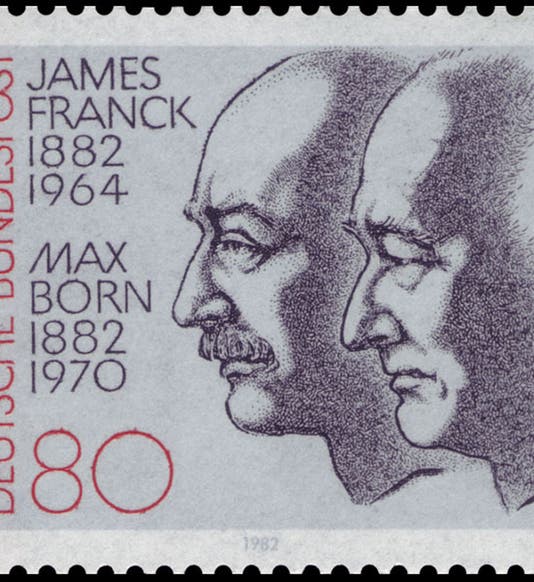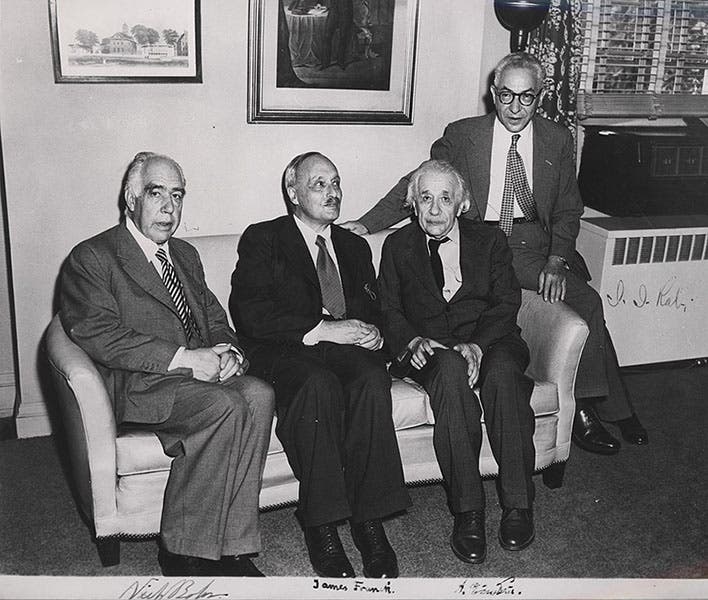Scientist of the Day - James Franck
James Franck, a German/American physicist, was born Aug. 26, 1882. In 1913, Niels Bohr proposed that the energy of the hydrogen atom is quantized, meaning that the electron that orbits the nucleus can have one packet or quantum of energy, or two, or three, but nothing in between. This was quite contrary to the prevailing notion that energy is continuous, and that an electron can have as little energy as it requires. But with his startling assumption, Bohr was able to explain why hydrogen atoms emit only certain wavelengths of light, as the electrons move from one quantum level of the atom to another. Later that same year, Franck collaborated with Gustav Hertz to test the Bohr hypothesis. They did an experiment that involved bombarding mercury atoms with electrons and measuring the speeds of the impacting electrons as well as the energy changes that took place in the mercury atoms. They were able to demonstrate that when a moving electron collides with a mercury atom, it always loses exactly the same amount of energy, about 5 electron volts (eV), which is the energy an electron has when travelling about 800 miles/second. If the electron is travelling faster than that, it slows down by an amount equivalent to 5 eV (and the electron in the mercury atom gains the 5 eV and jumps to a higher quantum level). And if it is travelling less than 800 miles/second, it doesn't lose any energy at all. Apparently the electron can only give up its energy in packets of 5 eV, and the electrons in the mercury atom can only accept energy in the same size packets. They presented their work in 1914; it was the first independent demonstration supporting Bohr's argument for the quantum atom, and it proved to be very convincing, impressing even the likes of Albert Einstein. Eleven years later, Franck and Hertz received the 1925 Nobel Prize in physics for this work. Franck, who was Jewish, had a good position at the University of Göttingen, but when Hitler rose to power, he resigned in protest in 1933 and emigrated to the United States, finally settling at the University of Chicago. He was thus well positioned to take an active role in the Manhattan Project, since the Project’s Met Lab, which oversaw the building of the first atomic pile, was located in Chicago. He also took a leading role in considering the social and cultural implications of atomic energy, and he headed up a committee that included such notable physicists as Glenn Seaborg and Leo Szilard, which issued a report in June of 1945, arguing against the use of atomic bombs on Japan and suggesting a demonstration as an alternative. The report is commonly called the Franck Report, and marked the beginning of a discussion that is still underway about the perils and ethics of nuclear warfare. It also sparked a realization in the scientific community that scientistsy now have a social and civic responsibility to see that society uses their work wisely.
At some point, Franck found time for the obligatory photograph session with Einstein, joining in this case Niels Bohr and I. I. Rabi. Einstein must have participated in hundreds of these; his gentle good humor nearly always managed to manifest itself in spite of what must have been a constant demand on his time and good graces. Finally, we recall a post we published two years ago about George de Hevesy, who in 1940 prevented the Nazis from confiscating two Nobel gold medals, placed in the custody of Niels Bohr in Copenhagen, by dissolving them in aqua regia and leaving the flask out in plain sight for the duration of the war. One of the medals he treated so brazenly was that of James Franck. After the war was over, the gold was retrieved from solution, sent back to Stockholm, recast into new medals, and Franck received his reminted medal at the University of Chicago in 1952. There is another portrait of Franck (and Hertz) on the Nobel Prize site, as well as a more detailed biography. The postage stamp with which we opened was issued in 1982 to honor the centennial birthdays of two Nobel Prize winners, Franck and Max Born. Dr. William B. Ashworth, Jr., Consultant for the History of Science, Linda Hall Library and Associate Professor emeritus, Department of History, University of Missouri-Kansas City. Comments or corrections are welcome; please direct to ashworthw@umkc.edu.







